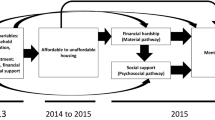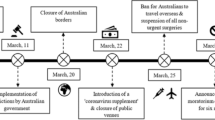Abstract
Purpose
When housing is insufficient, or poor quality, or unaffordable there are well established health effects. Despite the pervasiveness of housing affordability problems (widely referred to as Housing Affordability Stress—HAS), little quantitative work has analysed long-term mental health effects. We examine the mental health effects of (prolonged and intermittent) patterns of exposure to housing affordability problems.
Methods
We analysed a large, nationally representative longitudinal population sample of individuals, following them over five-year periods to assess the relative mental health effects of different patterns of exposure to housing affordability problems. To maximise the number of observations and the robustness of findings, we used 15 years (2002–2016) of data, across three pooled exposure windows. Longitudinal regression analysis with Mundlak adjustment was used to estimate the association between prolonged (constant over a 5-year period) and intermittent exposure to HAS, and mental health (as measured using the SF-36 MCS).
Results
We found that, on average, both prolonged and intermittent exposure were associated with lower mental health (Beta = − 1.338 (95% CI − 2.178–0.488) and Beta = − 0.516 (95% CI − 0.868–0.164), respectively). When we additionally adjusted for baseline mental health, thereby accounting for initial mental health status, coefficients were attenuated but remained significant.
Conclusions
Both prolonged and intermittent exposure to HAS negatively impact mental health, irrespective of baseline mental health. Interventions that target affordable housing would benefit population mental health. Mental health interventions should be designed with people’s housing context in mind.
Similar content being viewed by others
References
Desmond M (2018) Heavy is the house: rent burden among the American urban poor. Int J Urban Reg Res 42(1):160–170
Wetzstein S (2017) The global urban housing affordability crisis. Urban Stud 54(14):3159–3177
Snow J (1855) On the mode of communication of cholera: John Churchill.
Taylor MP, Pevalin DJ, Todd J (2007) The psychological costs of unsustainable housing commitments. Psychol Med 37:1027–1036
Free S, Howden-Chapman P, Pierse N, Viggers H (2010) More effective home heating reduces school absences for children with asthma. J Epidemiol Community Health 64:379–386
Mason KE, Baker E, Blakely T, Bentley RJ (2013) Housing affordability and mental health: does the relationship differ for renters and home purchasers? Soc Sci Med 94:91–97
Pollack CE, Griffin BA, Lynch J (2010) Housing affordability and health among homeowners and renters. Am J Prev Med 39:515–521
Waldron R, Redmond D (2017) “We’re just existing, not living!” Mortgage stress and the concealed costs of coping with crisis. Hous Stud 32:584–612
Baker E, Bentley R, Lester L, Beer A (2016) Housing affordability and residential mobility as drivers of locational inequality. Appl Geogr 72:65–75
Meltzer R, Schwartz A (2016) Housing affordability and health: evidence From New York city. Hous Policy Deb 26:80–104
Boymal J, de Silva A, Pomeroy J (2013) Quantity and quality estimates of changes in dwelling affordability in metropolitan Melbourne. Aust J Reg Stud 19:4
Cai W, Lu X (2015) Housing affordability: beyond the income and price terms, using China as a case study. Habit Int 47:169–175
Bentley R, Baker E, Mason K (2012) Measuring the dose-dependent mental health effect of poor housing affordability for men and women. J Epidemiol Community Health 66:761–766
Clair A, Loopstra R, Reeves A, McKee M, Dorling D, Stuckler D (2016) The impact of housing payment problems on health status during economic recession: A comparative analysis of longitudinal EU SILC data of 27 European states, 2008–2010. SSM-Popul Health 2:306–316
Bentley RJ, Pevalin D, Baker E, Mason K, Reeves A, Beer A (2016) Housing affordability, tenure and mental health in Australia and the United Kingdom: a comparative panel analysis. Hous Stud 31:208–222
Bentley R, Baker E, Mason K, Subramanian S, Kavanagh AM (2011) Association between housing affordability and mental health: a longitudinal analysis of a nationally representative household survey in Australia. Am J Epidemiol 174:753–760
Baker E, Mason K, Bentley R, Mallett S (2014) Exploring the bi-directional relationship between health and housing in Australia. Urban Policy Res 32(1):71–84
Bentley R, Baker E, Aitken Z (2019) The ‘double precarity’of employment insecurity and unaffordable housing and its impact on mental health. Soc Sci Med 225:9–16
Yates J, Gabriel M. Housing Affordability in Australia; National Research Venture 3: Housing Affordability for Lower Income Australians, Research Paper 3. AHURI Melbourne 2006.
Yates J, Milligan V, Berry M, et al. Housing affordability: a 21st century problem. National research venture 2007; 3.
Nepal B, Tanton R, Harding A (2010) Measuring housing stress: how much do definitions matter? Urban Policy Res 28:211–224
Daniel, L., Baker, E. and Lester, L., 2018. Measuring Housing Affordability Stress: Can Deprivation Capture Risk Made Real?. Urban Policy and Research, pp.1–16.
Rowley S, Ong R, Haffner M (2015) Bridging the gap between housing stress and financial stress: the case of Australia. Hous Stud 30:473–490
Commonwealth of Australia (1991) The affordability of Australian housing. National Housing Strategy, Issues papers 2.
Baker E, Mason K, Bentley R (2015) Measuring housing affordability: a longitudinal approach. Urban Policy Res 33:275–290
Seelig T, Phibbs P (2006) Beyond the normative: low income private renters’ perspectives of housing affordability and need for housing assistance. Urban Policy Res 24:53–66
Borrowman L, Kazakevitch G, Frost L. How long do households remain in housing affordability stress? Housing Studies 2017: 1–18.
Kahn JR, Pearlin LI (2006) Financial strain over the life course and health among older adults. J Health Soc Behav 47(1):17–31
Pevalin DJ, Reeves A, Baker E, Bentley R (2017) The impact of persistent poor housing conditions on mental health: a longitudinal population-based study. Prev Med 105:304–310
Evans GW, Cassells RC (2014) Childhood poverty, cumulative risk exposure, and mental health in emerging adults. Clin Psychol Sci 2(3):287–296
Seelig HJ, O'Flaherty M, Short P, Haynes MA, Baum SW, Western MC, Jones A (2005) Housing consumption patterns and earnings behaviour of income support recipients over time. Australian Housing and Urban Research Institute (AHURI), Melbourne
Summerfield M, Freidin S, Hahn M et al (2011) HILDA user manual–release 10. University of Melbourne Melbourne Institute of Applied Economic and Social Research, Melbourne
Coons SJ, Rao S, Keininger DL, Hays RD (2000) A comparative review of generic quality-of-life instruments. Pharmacoeconomics 17:13–35
McCallum J (1995) The SF-36 in an Australian sample: validating a new, generic health status measure. Aust N Z J Public Health 19:160–166
Pirkis J, Burgess P, Kirk P, Dodson S, Coombs T (2005) Review of standardised measures used in the National Outcomes and Casemix Collection (NOCC). Sydney, NSW
Allison PD (2009) Fixed effects regression models. SAGE publications, Thousand Oaks
Ware JE, Gandek B (1998) Overview of the SF-36 health survey and the international quality of life assessment (IQOLA) project. J Clin Epidemiol 51:903–912
Ware JE, Keller SD, Kosinski M (1994) SF-36: Physical and mental health summary scales: a user’s manual: Health Assessment Lab.
Baker E, Pham NTA, Daniel L, Bentley R (2020) New evidence on mental health and housing affordability in cities: a quantile regression approach. Cities 96:102455
Watson N, Wooden M (2010) Data survey: the HILDA survey: progress and future developments. Australian Econ Rev 43(3):326–336
Baker E, Lester L (2017) Multiple housing problems: a view through the housing niche lens. Cities 62:146–151
Acknowledgements
This paper uses unit record data from the Household, Income and Labour Dynamics in Australia (HILDA) Survey. The HILDA Project was initiated and is funded by the Australian Government Department of Social Services (DSS) and is managed by the Melbourne Institute of Applied Economic and Social Research (Melbourne Institute). The findings and views reported in this paper, however, are those of the author and should not be attributed to either DSS or the Melbourne Institute
Author information
Authors and Affiliations
Corresponding author
Ethics declarations
Conflict of interest
On behalf of all authors, the corresponding author states that there is no conflict of interest.
Rights and permissions
About this article
Cite this article
Baker, E., Lester, L., Mason, K. et al. Mental health and prolonged exposure to unaffordable housing: a longitudinal analysis. Soc Psychiatry Psychiatr Epidemiol 55, 715–721 (2020). https://doi.org/10.1007/s00127-020-01849-1
Received:
Accepted:
Published:
Issue Date:
DOI: https://doi.org/10.1007/s00127-020-01849-1




